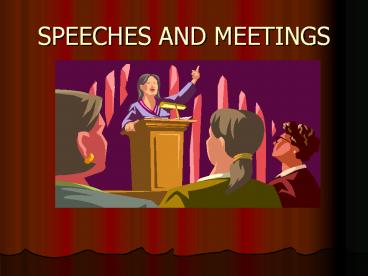SPEECHES AND MEETINGS PowerPoint PPT Presentation
1 / 10
Title: SPEECHES AND MEETINGS
1
SPEECHES AND MEETINGS
2
Common Coverage Scenarios
- Speeches and meetings are two common sources for
everyday news stories and coverage. - Newspapers often publish two stories about major
speeches and meetings an advance story before
the speech or meeting and a follow story, which
reports on the speech or meeting itself.
3
Advance Stories
- Advance stories or advancers alert readers,
listeners or viewers to upcoming events they may
want to attend, support, oppose, or at least pay
attention to because they may affect them. - Most advance stories are published the same day a
speech or meeting is announced, or shortly
thereafter. - As a reminder to their audiences, news
organizations may publish a second advance story
a day or two before the speech or meeting occurs.
4
Advancers
- Advance stories are usually fairly brief,
emphasizing the basic facts of what will
happen, when and where it will happen, and who
will be involved. - The leads for these stories should stress what is
important or unusual, not just the fact that
someone has scheduled a speech or meeting.
5
Follow Stories
- Follow Stories or Covering a Speech or
Meetingcovering these effectively requires
perfecting some basic reporting skills advance
preparation, sound news judgment, accuracy, an
ear for interesting quotations and an eye for
compelling details. - Follow stories are published or broadcast after
speeches or meetings, reporting on those events
in detail. Therefore, they are much longer than
advance stories. They are also harder to
write.
6
Tips on covering speeches/meetings
- Arrive early and find a seat that will allow you
to hear and see as much as possible - Introduce yourself, either before or after, to
the speakers and participants, if you have not
met them before - Take detailed notesto help you recall and
understand what was said or done - Bring a tape or digital recorder to ensure
accuracy - As you listen to a speech or meeting, try to
think of groups or individuals who might have
different points of view or who might be affected
by actions taken. And then try to speak to these
individuals or groups later so you provide
readers or viewers with as complete a news story
as possible (and as balanced as possible)
7
Writing Meeting and Speech Articles
- It is important to identify a central point.
What is most newsworthy about the speech or
meeting you are covering? - There may be multiple newsworthy points to come
out, so the reporter needs to organize the story
so the most important topic is mention and
covered first, in the lead. Or have a compound
lead mentioning two or three important topics. - Also, you can summarize the major topic, then
after a brief transition, use bullet points to
hit on the other key things that came out of the
speech or meeting.
8
Leads, as always very important
- Writing effective leads avoid leads that are so
broad or general that they contain no news. See
examples on page 316. - After the lead, organize the story in inverted
pyramid fashion, not according to the order in
which statements were made or topics considered.
9
More Tips
- Vary the location of the attribution in direct
and indirect quotes, so that the story does not
become monotonous. - Provide transitions from one topic to another
- Avoid generalities and eliminate or explain
jargon or technical terms.
10
And finally
- Check controversial or questionable facts or
assertions and give any person who has been
attacked in the speech or meeting an opportunity
to respond. - Include color in speech or meeting stories by
providing direct quotations and descriptions of
speakers, participants, settings and audience
responses. - See also tips for covering speeches and meetings
on page 322

